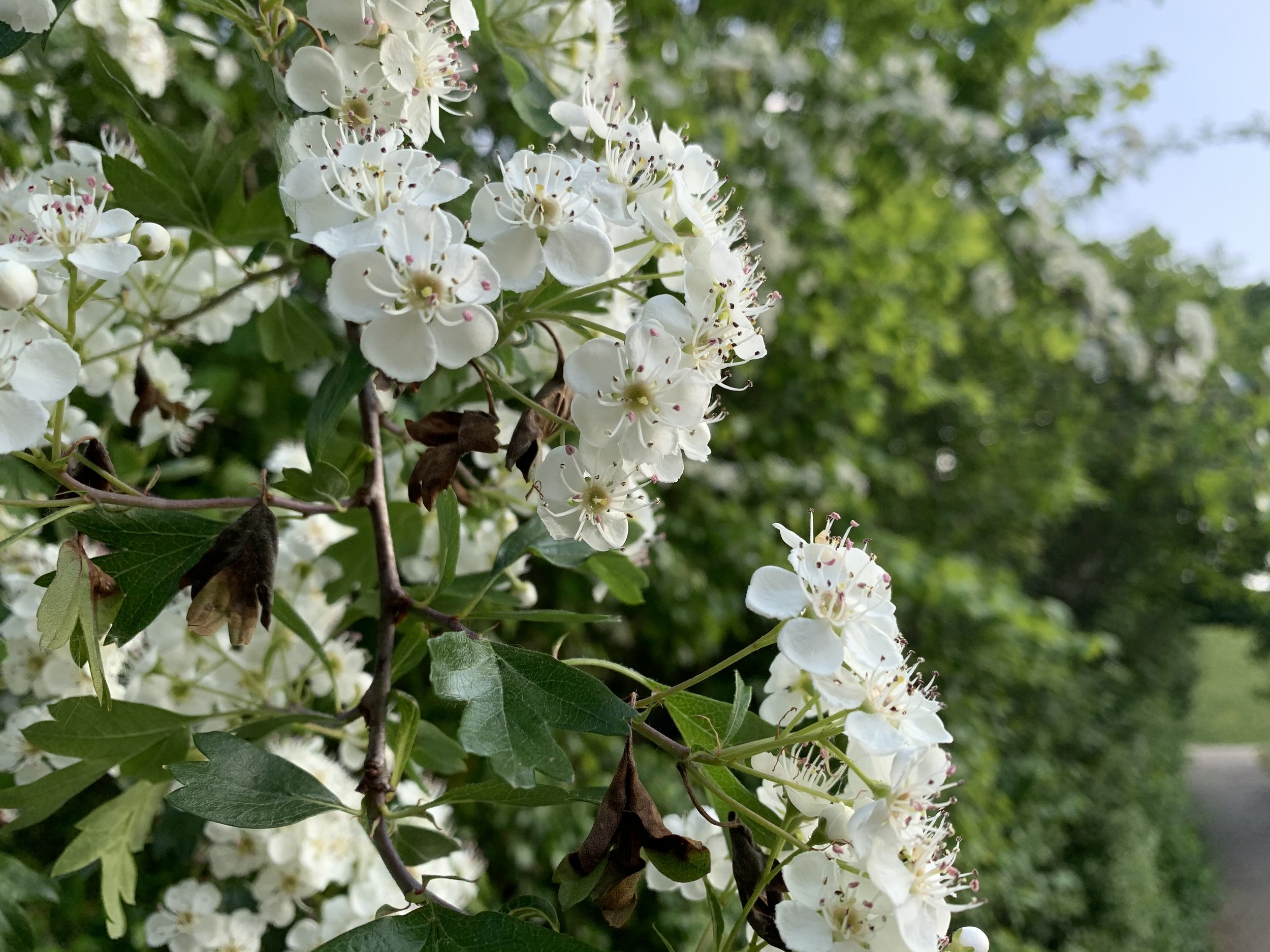The Hedge Thorn
It’s the beginning of May, which means the Hawthorn trees are blooming and nature's spring symphony is (hopefully) in full swing. Hawthorn is one of the most prominent plants of the British Isles, where we primarily have two varieties, Crataegus monogyna (the Common Hawthorn) and Crataegus laevigata (the Midland Hawthorn). A member of the rose family, Hawthorns can be found growing either as small deciduous trees or as hedgerow shrubs, with some reaching heights of up to 30 feet. But it’s far more common to find them tangled into hedges along with brambles and other shrubs, leading to its name hægþorn in Old English, literally meaning ‘thorn of the boundary hedge.’
For the ancient Celts, the Hawthorn was seen as a powerful tree, often standing at entrances to the otherworld. One of its common names, the Mayflower, speaks to the clusters of white flowers that emerge in late Spring, traditionally used in May Day celebrations well into the 20th century. It’s even the namesake of the famed ship that carried early English ‘Pilgrims’ to North America in the 17th century. But Hawthorn was rarely seen as a strictly auspicious plant. The flowers contain a stinky chemical known as trimethylamine, a prominent component of the ‘smell of death’ that arises from decaying animal tissue. This is undoubtedly one of the reasons that keeping boughs of Hawthorn flowers in the home was once seen as an invitation to misfortune, even though there were some exceptions to this rule at special times.
Things became particularly precarious when dealing with a solitary Hawthorn tree, standing alone in a meadow or field instead of being nestled in a hedge or thicket. These lone thorns were often viewed as sentinels, standing at the gateways to the otherworld, or as the flowering crown of a fairy fort. To disturb such a tree on May Day, Midsummer, or Samhain was seen to be a supremely risky act, as it might incur the wrath of the unseen beings. Felling any Hawthorn tree was, in many parts of Britain, something to be altogether avoided. There are countless stories of farmers clearing out Hawthorns to ‘tidy the farm,’ only to be met with broken bones, unproductive livestock, and illness. In one particularly interesting story, a farmer in Herefordshire is said to have begun chopping away at a thorn until it started bleeding from its wounded trunk, causing him to recoil in terror.[i]
Millions of tourists visit Glastonbury Tor every year, considered by many to be the spiritual heart of Great Britain. While most people make their way up the dirt path to take in the view beneath the towering remains of the Church of St. Michael, few realise that just a few paces away there is a far more enchanting site. On the south face of the hill lies a conspicuous round rock known as the ‘Egg Stone,’ which sits beside a small bunch of Hawthorn trees. According to legend, a 7th century monk named St. Collen visited the Tor with the intent of banishing the local fair folk from the premises. Glastonbury had long been held to be the abode of Gwyn ap Nudd, king of Annwn - the Welsh underworld – and the Egg Stone was understood to be the proper entrance. Collen sat himself down at the stone and sought a parlay with the fairy king. He was transported into the belly of the Tor, where he was ushered into the court of the king and offered a royal fairy feast – but dutifully avoided accepting any of their enchanted offerings. Instead, he threw holy water at his hosts in an attempt to banish them, causing them to immediately return him to his resting place beside the Egg Stone.
Today, offerings of coloured threads and ribbons decorate the Hawthorn trees that stand beside this otherworldly portal, but they are far from the most famous thorns of Glastonbury. Unlike many other sacred ‘pagan’ plants, Hawthorn is one of the few to have successfully found a place in Christian mythology, particularly in England and Ireland. Some state that it was a Hawthorn crown that adorned Jesus’s head at his crucifixion, while other stories state that, “Under a thorn, our saviour was born.”[ii] These associations with Christian mythology were further cemented with the legend of the famed ‘Glastonbury Thorn,’ once located on Wearyall Hill, which is said to have sprouted from the walking stick of Joseph of Arimathea who, according to legends arising from around the 13th century, travelled to England along with the Holy Grail after Jesus’s crucifixion. The tree was unusual in that it blossomed not only in the late Spring, but also at Christmas. While the original tree is long gone, their various descendants can be found bursting into midwinter bouquets of white flowers all around Glastonbury. For hundreds of years, it has been customary for the Vicar and Mayor of Glastonbury to send a Hawthorn branch to adorn the Christmas dinner table of the Sovereign – a tradition that continues to this day.
Hawthorns are not merely a British plant, of course, and there are at least 200 species found across the temperate regions of Eurasia, North Africa, and North America. They form an important habitat for various birds and mammals, and their abundant flowers are a key source of nourishment for pollinators leading into the summer months. Since haws often remain on the trees well into the winter, birds like thrushes rely on them as a key source of food during the cold season.
Of course, they have culinary value for humans as well! Young leaves and flower buds are known in rural England as ‘bread and cheese,’ and make a lovely addition to salads and other dishes. The fruits can be made into jams and wine, or eaten raw as an apple-like snack. But Hawthorn is certainly most famous for their medicinal properties. In traditional medicine, the haws were used principally as a digestive remedy, but modern herbalists mainly identify them as a specific medicine for the heart. Clinical trials support its use for heart disease due to ischaemia and hypertension, as well as anxiety (in combination with other supportive herbs), and there is abundant anecdotal evidence suggesting its efficacy for a wide range of mild heart conditions including angina and arterial degeneration due to atherosclerosis.[iii] Hawthorn’s widespread use as a heart tonic emerged only in the late 19th century, when an Irish physician named Dr. Greene used a tincture produced from the berries to gain widespread renown as a skilled healer of heart disease.
In a 2008 Cochrane review of fourteen clinical trials, researchers found that Hawthorn preparations made from the leaves and flowers, which are highest in oligomeric procyanidins (OPCs), had a marked effect on cardiac function in heart failure patients, improving symptoms like fatigue and breathlessness while supporting the heart muscle to work more efficiently.[iv] Its antioxidant flavonoids and procyanidins operate as ‘cooling’ medicines for a stressed out heart, useful in cases of stress and overwhelm. Patients who experience frequent agitation and ‘overheating,’ especially with cardiac symptoms, often benefit from Hawthorn’s capacity to establish healthy boundaries. Our hearts are complex perceptual organs, picking up on subtle changes in our energetic environment and the experiences of other beings around us. The heart’s experience directly impacts our autonomic nervous system, ultimately informing the emotional experiences arising in the amygdala and right frontal cortex.[v]
In the Tibetan medical tradition, this dynamic can be understood through the traditional disease categories of nying-loong (heart-wind) and nying-tsé (heart-heat), conditions which are closely connected both to our physiological and psychological health. Heart-wind is a very common ailment in the modern world, especially in western societies, manifesting through symptoms including tachycardia, anxiety, insomnia, and emotional dysregulation. In traditional Tibetan pharmacology, remedies often include the wood of the exceedingly rare Aquilaria agallocha tree, commonly known as Agarwood, famed for its immense value as an aromatic substance. But in my clinical experience, Hawthorn is a helpful and sustainable substitution for this threatened species, despite having slightly different tastes and qualities.
While Hawthorn can be used in many ways, including in tea, capsules, or as food, my favourite method of preparation is tincturing. When the flowers emerge in late spring, I collect the young leaves and flowers and macerate them in alcohol, leaving them to sit in a dark place for the remainder of the summer. When autumn comes and the haws ripen, I strain out the leaves and flowers and macerate the berries in the same alcoholic extract, creating a dynamic ‘double-extracted’ blend from the numerous different medicinal substances offered by the tree. If you’d like, you can also toss in a single thorn from the plant for good measure. I usually calcine the dregs from the process to produce a pure mineral salt, which is slowly circulated back into the tincture, but this is a far more complicated process that requires careful guidance.
For an example of how I process Hawthorn to create spagyric tinctures, click here.
Hawthorn is a powerful medicine, but it is also a powerful plant all on its own. We don’t need to pick their flowers or berries to appreciate their magic, and in some cases it is likely best that we simply let them be. But next time you see a Hawthorn, be sure to take a moment to simply experience this incredible plant. Allow your heart to open to the lived experience of the Hawthorn itself, and the strength that it embodies. And if you have a bit of free space in your garden, perhaps considering planting one of these special trees, or even an entire hedge!


